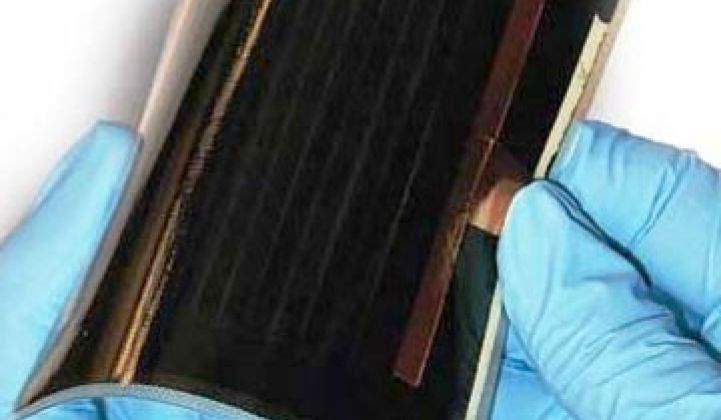ZSW, a German research institute focused on solar and hydrogen, announced today that it has developed a copper indium gallium selenide (CIGS) solar cell to convert 20.3 percent of the light that strikes it into electricity.
This nudges past the record set by ZSW in April with a cell with a 20.1 percent efficiency. The April mark broke a longstanding record held by NREL and also market the first time CIGS got past the 20 percent barrier.
CIGS cells and modules constitute almost an invisible fraction of a percentage of the solar market. Many CIGS companies, in fact, have just begun to sell modules and a large number are still in the pre-commercialization state. Nonetheless, that may change over the coming years. CIGS cells can operate at higher efficiencies than cadmium telluride and amorphous silicon solar cells, and ultimately they should cost less to produce than crystalline silicon cells. CIGS can also be placed on flexible substrates, hence the building integrated CIGS modules coming from Dow.
ZSW estimates that generic CIGS panels will rise from 11 percent efficiency today to 15 percent over the next few years. Solar power plants built around thin-film solar cells will rise from the teens today to 30 percent by 2012, the company added.
Meanwhile, it was 50 years ago that construction began on Geysers, the world's first commercial geothermal plant, according to the Geothermal Energy Association. Geothermal now provides over 3 gigawatts of power in the U.S. at 77 locations in nine states. Approximately 188 new projects are now underway. New techniques such as hot dry rock technology and better drilling techniques may expand geothermal from its traditional base on the Pacific Rim and Nevada to other locations in the U.S. Geothermal is cheaper than other renewables and can provide consistent baseline-quality power, say advocates.
Speaking of dirt and dust, Boston University researchers say it might be possible to commercialize a self-dusting technology employed by NASA for its solar panels on the Mars rover mission. In a nutshell, an additional, electrically sensitive layer is added to solar modules. Sensors detect dust pile-up and then trigger an electronic charge to sweep it away. In principle, it's like an electronic hand buzzer, but for solar panels. Debris does chronically reduce the efficiency of earth-bound solar panels. Earth panels, however, also suffer from water spots, snow and bird droppings. Thus, expect to see an intense cost/benefit/functionality debate here. Still, for utility-scale plants in the desert this could be handy.
Finally, Japan's government is considering subsidizing energy efficient power plants. Considering that some of the large conglomerates are also the largest producers of solar panels and efficiency equipment, this will ideally help employment, as well.



